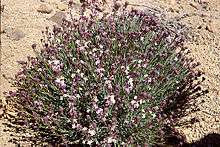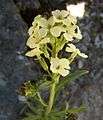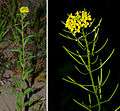Erysimum
Erysimum, or wallflower, is a genus of flowering plants in the cabbage family, Brassicaceae. It includes more than 150 species, both popular garden plants and many wild forms.[1][2][3][4][5][6] The genus Cheiranthus is sometimes included here in whole or in part. Erysimum has since the early 21st century been ascribed to a monogeneric cruciferous tribe, Erysimeae, characterised by sessile, stellate (star-shaped) and/or malpighiaceous (two-sided) trichomes, yellow to orange flowers and multiseeded siliques.
| Erysimum | |
|---|---|
 | |
| Erysimum scoparium | |
| Scientific classification | |
| Kingdom: | Plantae |
| Clade: | Tracheophytes |
| Clade: | Angiosperms |
| Clade: | Eudicots |
| Clade: | Rosids |
| Order: | Brassicales |
| Family: | Brassicaceae |
| Genus: | Erysimum L. |
| Species | |
|
Over 180, see text | |
| Synonyms | |
| |
Morphology
Wallflowers are annuals, herbaceous perennials or sub-shrubs. The perennial species are short-lived and in cultivation treated as biennials. Most species have stems erect, somewhat winged, canescent with an indumentum of bifid hairs, usually 25 ± 53 cm × 2–3 mm in size, and t-shaped trichomes. The leaves are narrow and sessile. The lower leaves are linear to oblanceolate pinnatifid with backwardly directed lobes, acute, 50–80 mm × 0.5–3 mm. Stem leaves are linear, entire, all canescent with 2-fid hairs; 21–43 mm × 1.5–2 mm. Inflorescences are produced in racemes, with bright yellow to red or pink bilateral and hermaphrodite, hypogynous and ebracteate flowers. Flowering occurs during spring and summer. One species, Erysimum semperflorens, native to Morocco and Algeria, has white flowers. The floral pedicel ranges from 4 to 7 mm. Four free sepals somewhat saccate, light green, 5–7 mm × 1.5–2 mm.
Etymology
The genus name Erysimum is derived from the Greek word 'Eryo' meaning to drag.[7]
Distribution
Wallflowers are native to southwest Asia, the Mediterranean, Europe, Africa (Cabo Verde), Micronesia, and North America through Costa Rica. Many wallflowers are endemic to small areas, such as:
- E. aetnense (Mount Etna)
- E. franciscanum (north Californian coast)
- E. kykkoticum (Cyprus – nearly extinct)
- E. moranii (Guadalupe Island)
- E. nevadense (the Sierra Nevada of Spain)
- E. scoparium (the Teide volcano on Tenerife)
- E. teretifolium (endangered – inland sandhills of Santa Cruz County, California)
Cultivation
Most wallflower garden cultivars (e.g. Erysimum 'Chelsea Jacket') are derived from E. cheiri (often placed in Cheiranthus), from southern Europe. They are often attacked by fungal and bacterial disease, so they are best grown as biennials and discarded after flowering. They are also susceptible to clubroot, a disease of Brassicaceae. Growth is best in dry soils with very good drainage, and they are often grown successfully in loose wall mortar, hence the vernacular name. There is a wide range of flower color in the warm spectrum, including white, yellow, orange, red, pink, maroon, purple and brown. The flowers, appearing in spring, usually have a strong fragrance. Wallflowers are often associated in spring bedding schemes with tulips and forget-me-nots.[8]
The cultivar 'Bowles's Mauve'[9] has gained the Royal Horticultural Society's Award of Garden Merit.[10] It can become a bushy evergreen perennial in milder locations. It is strongly scented and attractive to bees.
Ecology
Erysimum is found in a range of habitats across the northern hemisphere, and has developed diverse morphology and growth habits (herbaceous annual or perennial, and woody perennial). Different Erysimum species are used as food plants by the larvae of some Lepidoptera (butterflies and moths) species including the garden carpet (Xanthorhoe fluctuata). In addition, some species of weevils, like Ceutorhynchus chlorophanus, live inside the fruits feeding on the developing seeds. Many species of beetles, bugs and grasshoppers eat the leaves and stalks. Some mammalian herbivores, for example mule deer (Odocoileus hemionus) in North America, argali (Ovis ammon) in Mongolia, red deer (Cervus elaphus) in Central Europe, or Spanish ibex (Capra pyrenaica) in the Iberian Peninsula, feed on wallflower flowering and fruiting stalks. Erysimum crepidifolium (pale wallflower) is toxic to some generalist vertebrate herbivores.[11][12]
Most wallflowers are pollinator-generalists, their flowers being visited by many different species of bees, bee flies, hoverflies, butterflies, beetles, and ants. However, there are some specialist species. For example, Erysimum scoparium is pollinated almost exclusively by Anthophora alluadii.
Defensive compounds
Like most Brassicaceae, species in the genus Erysimum produce glucosinolates as defensive compounds.[13][14] However, unlike almost all other genera in the Brassicaceae, Erysimum also accumulates cardiac glycosides, another class of phytochemicals with an ecological importance in insect defense.[15][16] Cardiac glycosides specifically function to prevent insect herbivory[17] and/or oviposition[18] by blocking ion channel function in muscle cells.[19] These chemicals are toxic enough to deter generalist,[20] and even some specialist[21] insect herbivores. Cardiac glycoside production is widespread in Erysimum, with at least 48 species in the genus containing these compounds.[16][22] Accumulation of cardiac glycosides in Erysimum crepidifolium, but not other tested species, is induced by treatment with jasmonic acid and methyl jasmonate,[23][22] endogenous elicitors of chemical defenses in many plant species.[24] Molecular phylogenetic analysis indicates that Erysimum diversification from other Brassicaceae species that do not produce cardiac glycosides began in the Pliocene (2.33–5.2 million years ago),[25][1] suggesting relatively recent evolution of cardiac glycosides as a defensive trait in this genus.
Escape from herbivory
The evolution of novel chemical defenses in plants, such as cardenolides in the genus Erysimum, is predicted to allow escape from herbivory by specialist herbivores and expansion into new ecological niches.[26] The crucifer-feeding specialist Pieries rapae (white cabbage butterfly) is deterred from feeding and oviposition by cardenolides in Erysimum cheiranthoides.[27][28][29][30][31] Similarly, Anthocharis cardamines (orange tip butterfly), which oviposits on almost all crucifer species, avoids E. cheiranthoides.[32] Erysimum asperum (western wallflower) is resistant to feeding and oviposition of Pieris napi macdunnoughii (synonym Pieris marginalis, margined white butterfly).[33][34] Two crucifer-feeding beetles, Phaedon sp. and Phyllotreta sp., were deterred from feeding by cardenolides that were applied to their preferred food plants.[35][36] Consistent with the hypothesis of enhanced speciation after escape from herbivory, phylogenetic studies involving 128 Erysimum species indicate diversification in Eurasia between 0.5 and 2 million years ago, and in North America between 0.7 and 1.65 million years ago.)[1] This evolutionarily rapid expansion of the Erysimum genus has resulted in several hundred known species distributed throughout the northern hemisphere.[1][2][3][4][5][6]
Ethnobotanical uses of Erysimum
Erysimum species have a long history of use in traditional medicine. In Naturalis Historia by Pliny the Elder (~77), Erysimum is classified as a medicinal rather than a food plant. Erysimum cheiri is described as a medicinal herb in De Materia Medica by Pedanius Dioscorides (~70), which was the predominant European medical pharmacopeia for more than 1,500 years. Other medieval descriptions of medicinal herbs and their uses, including the Dispensatorium des Cordus by Valerius Cordus (1542), Bocks Kräuterbuch by Hieronymus Bock (1577), and Tabernaemontanus’ Neuw Kreuterbuch by Jacobus Theodorus Tabernaemontanus (1588), also discuss applications of E. cheiri. In traditional Chinese medicine, Erysimum cheiranthoides has been used to treat heart disease and other ailments.[37] Although medical uses of Erysimum became uncommon in Europe after the Middle Ages,[38] Erysimum diffusum, as well as purified erysimin and erysimoside, have been applied more recently as Ukrainian ethnobotanical treatments.[39]
Selected species
|
|
Gallery
 Erysimum wittmanii inflorescence
Erysimum wittmanii inflorescence
 Erysimum helveticum
Erysimum helveticum- Erysimum allionii inflorescence
 Erysimum × linifolium 'Bowles's Mauve'
Erysimum × linifolium 'Bowles's Mauve'
References
- Moazzeni, Hamid; Zarre, Shahin; Pfeil, Bernard E.; Bertrand, Yann J. K.; German, Dmitry A.; Al-Shebaz, Ihsan A.; Mummenhoff, Klaus; Oxelman, Bengt (2014). "Phylogenetic perspectives on diversification and character evolution in the species-rich genus Erysimum (Erysimeae; Brassicaceae) based on a densely sampled ITS approach". Botanical Journal of the Linnean Society. 175 (4): 497–522. doi:10.1111/boj.12184.
- Al-Shehbaz, Ihsan A.; Windham, Michael D.; Warwick, Suzanne I.; O'Kane, Steve L.; Mummenhoff, Klaus; Mayer, Michael; Koch, Marcus A.; Bailey, C. Donovan (2006). "Toward a Global Phylogeny of the Brassicaceae". Molecular Biology and Evolution. 23 (11): 2142–2160. doi:10.1093/molbev/msl087. ISSN 0737-4038. PMID 16916944.
- Rollins, Reed Clark. (1993). The 'Cruciferae' of continental North America : systematics of the mustard family from the Arctic to Panama. Stanford University Press. ISBN 0804720649. OCLC 610871656.
- Polatschek, Adolf (1976). "Die Gattung Erysimum auf den Kapverden, Eanaren und Madeira". Annalen des Naturhistorischen Museums in Wien. 80: 93–103. ISSN 0083-6133. JSTOR 41769598.
- Polatschek, A. (2013). "Revision der Gattung Erysimum (Cruciferae): Teil 5. Nord-, West-, Zentraleuropa, Rumänien und westliche Balkan-Halbinsel bis Albanien". Annalen des Naturhistorischen Museums in Wien. Serie B für Botanik und Zoologie. 115: 75–218. ISSN 0255-0105. JSTOR 43922111.
- Polatschek, A. (2013). "Revision der Gattung Erysimum (Cruciferae): Teil 4. Nordafrika, Malta und Zypern". Annalen des Naturhistorischen Museums in Wien. Serie B für Botanik und Zoologie. 115: 57–74. ISSN 0255-0105. JSTOR 43922110.
- Archibald William Smith A Gardener's Handbook of Plant Names: Their Meanings and Origins, p. 148, at Google Books
- RHS A-Z encyclopedia of garden plants. United Kingdom: Dorling Kindersley. 2008. p. 1136. ISBN 978-1405332965.
- "Erysimum 'Bowles's Mauve'". Royal Horticultural Society. Archived from the original on 6 November 2011. Retrieved 26 July 2013.
- "AGM Plants - Ornamental" (PDF). Royal Horticultural Society. July 2017. p. 45. Retrieved 2 May 2018.
- Roth, Lutz. (1994). Giftpflanzen, Pflanzengifte : Giftpflanzen von A-Z : Notfallhilfe : Vorkommen, Wirkung, Therapie : allergische und phototoxische Reaktionen. Ecomed. ISBN 3609648104. OCLC 891791701.
- Bleicher Schöterich (Erysimum crepidifolium). In: giftpflanzen.com.
- Fahey, Jed W.; Zalcmann, Amy T.; Talalay, Paul (2001). "The chemical diversity and distribution of glucosinolates and isothiocyanates among plants". Phytochemistry. 56 (1): 5–51. doi:10.1016/S0031-9422(00)00316-2. PMID 11198818.
- Züst, Tobias; Strickler, Susan R; Powell, Adrian F; Mabry, Makenzie E; An, Hong; Mirzaei, Mahdieh; York, Thomas; Holland, Cynthia K; Kumar, Pavan; Erb, Matthias; Petschenka, Georg; Gómez, José-María; Perfectti, Francsco; Müller, Caroline; Pires, J Chris; Mueller, Lukas; Jander, Georg (2020-04-07). "Independent evolution of ancestral and novel defenses in a genus of toxic plants (Erysimum, Brassicaceae)". eLife. 9: e51712. doi:10.7554/eLife.51712. ISSN 2050-084X. PMC 7180059. PMID 32252891.
- Züst, Tobias; Mirzaei, Mahdieh; Jander, Georg (2018-03-20). "Erysimum cheiranthoides, an ecological research system with potential as a genetic and genomic model for studying cardiac glycoside biosynthesis". Phytochemistry Reviews. 17 (6): 1239–1251. doi:10.1007/s11101-018-9562-4. ISSN 1568-7767.
- Makarevich, FI; Zhernoklev, KV; Slyusarskaya, TB (1994). "Cardenolide-containing plants of the family Cruciferae". Chemistry of Natural Compounds. 30 (3): 275–289. doi:10.1007/BF00629957.
- Dussourd, DE; Hoyle, AM (2000). "Poisoned plusiines: toxicity of milkweed latex and cardenolides to some generalist caterpillars". Chemical Ecology. 10.
- Renwick, J. A. A.; Radke, C. D.; Sachdev-Gupta, K. (1989). "Chemical Constituents of Erysimum cheiranthoides Deterring Oviposition by the Cabbage Butterfly, Pieris rapae". Journal of Chemical Ecology. 15 (8): 2161–9. doi:10.1007/BF01014106. PMID 24272377.
- Paula, S; Tabet, MR; Ball, WJ (2005). "Interactions between cardiac glycosides and sodium ⁄ potassium-ATPase: three-dimensional structure)activity relationship models for ligand binding to the E2-Pi form of the enzyme versus activity inhibition". Biochemistry. 44 (2): 498–510. doi:10.1021/bi048680w. PMID 15641774.
- Karowe, DN; Golston, V (2006). "Effect of the cardenolide digitoxin on performance of gypsy moth (Lymantria dispar) (Lepidoptera: Lymantriidae) caterpillars". The Great Lakes Entomologist. 39.
- Rassman, s; Johnson, MD; Agrawal, AA (2009). "Induced responses to herbivory and jasmonate in three milkweed species". Journal of Chemical Ecology. 35.
- Züst, Tobias; Strickler, Susan R.; Powell, Adrian F.; Mabry, Makenzie E.; An, Hong; Mirzaei, Mahdieh; York, Thomas; Holland, Cynthia K.; Kumar, Pavan (2019-09-08). "Rapid and independent evolution of ancestral and novel defenses in a genus of toxic plants (Brassicaceae)". bioRxiv. doi:10.1101/761569.
- Munkert, Jennifer; Ernst, Mona; Müller-Uri, Frieder; Kreis, Wolfgang (2014). "Identification and stress-induced expression of three 3β-hydroxysteroid dehydrogenases from Erysimum crepidifolium Rchb. and their putative role in cardenolide biosynthesis". Phytochemistry. 100: 26–33. doi:10.1016/j.phytochem.2014.01.006. ISSN 0031-9422. PMID 24512841.
- Howe, Gregg A.; Jander, Georg (2008). "Plant Immunity to Insect Herbivores". Annual Review of Plant Biology. 59 (1): 41–66. doi:10.1146/annurev.arplant.59.032607.092825. ISSN 1543-5008. PMID 18031220.
- Huang, Chien-Hsun; Sun, Renran; Hu, Yi; Zeng, Liping; Zhang, Ning; Cai, Liming; Zhang, Qiang; Koch, Marcus A.; Al-Shehbaz, Ihsan; Edger, Patrick P.; Pires, J. Chris; Tan, Dun-Yan; Zhong, Yang; Ma, Hong (2015). "Resolution of Brassicaceae Phylogeny Using Nuclear Genes Uncovers Nested Radiations and Supports Convergent Morphological Evolution". Molecular Biology and Evolution. 33 (2): 394–412. doi:10.1093/molbev/msv226. PMC 4866547. PMID 26516094.
- Weber, Marjorie G.; Agrawal, Anurag A. (2014). "Defense mutualisms enhance plant diversification". Proceedings of the National Academy of Sciences. 111 (46): 16442–16447. Bibcode:2014PNAS..11116442W. doi:10.1073/pnas.1413253111. ISSN 0027-8424. PMC 4246327. PMID 25349406.
- Feeny, Paul (1977). "Defensive Ecology of the Cruciferae". Annals of the Missouri Botanical Garden. 64 (2): 221–234. doi:10.2307/2395334. JSTOR 2395334.
- Renwick, J. A. A.; Radke, Celia D. (1987). "Chemical stimulants and deterrents regulating acceptance or rejection of crucifers by cabbage butterflies". Journal of Chemical Ecology. 13 (7): 1771–1776. doi:10.1007/bf00980217. ISSN 0098-0331. PMID 24302344.
- Renwick, J. A. A.; Radke, Celia D. (1985). "Constituents of host- and non-host plants deterring oviposition by the cabbage butterfly, Pieris rapae". Entomologia Experimentalis et Applicata. 39 (1): 21–26. doi:10.1111/j.1570-7458.1985.tb03538.x. ISSN 0013-8703.
- Dimock, M. B.; Renwick, J. A. A.; Radke, C. D.; Sachdev-gupta, K. (1991). "Chemical constituents of an unacceptable crucifer,Erysimum cheiranthoides, deter feeding byPieris rapae". Journal of Chemical Ecology. 17 (3): 525–533. doi:10.1007/bf00982123. ISSN 0098-0331. PMID 24258803.
- Sachdev-Gupta, K.; Radke, Cd.; Renwick, J. A. A.; Dimock, M. B. (1993). "Cardenolides fromErysimum cheiranthoides: Feeding deterrents toPieris rapae larvae". Journal of Chemical Ecology. 19 (7): 1355–1369. doi:10.1007/bf00984881. ISSN 0098-0331. PMID 24249167.
- Wiklund, Christer; Åhrberg, Carl; Ahrberg, Carl (1978). "Host Plants, Nectar Source Plants, and Habitat Selection of Males and Females of Anthocharis cardamines (Lepidoptera)". Oikos. 31 (2): 169. doi:10.2307/3543560. ISSN 0030-1299. JSTOR 3543560.
- Chew, Frances S. (1975). "Coevolution of pierid butterflies and their cruciferous foodplants". Oecologia. 20 (2): 117–127. Bibcode:1975Oecol..20..117C. doi:10.1007/bf00369024. ISSN 0029-8549. PMID 28308818.
- Chew, Frances S. (1977). "Coevolution of Pierid Butterflies and Their Cruciferous Foodplants. II. The Distribution of Eggs on Potential Foodplants". Evolution. 31 (3): 568–579. doi:10.2307/2407522. ISSN 0014-3820. JSTOR 2407522.
- NIELSEN, JENS KVIST (1978). "Host Plant Discrimination within Cruciferae: Feeding Responses of Four Leaf Beetles (Coleoptera: Chrysomelidae) to Glucosinolates, Cucurbitacins and Cardenolides". Entomologia Experimentalis et Applicata. 24 (1): 41–54. doi:10.1111/j.1570-7458.1978.tb02755.x. ISSN 0013-8703.
- NIELSEN, J. K. (1978). "Host Plant Selection of Monophagous and Oligophagous Flea Beetles Feeding on Crucifers". Entomologia Experimentalis et Applicata. 24 (3): 562–569. doi:10.1111/j.1570-7458.1978.tb02817.x. ISSN 0013-8703.
- Zhu, YC (1989). Plantae Medicinales Chinae Boreali-Orientalis. Harbin: Heilongjiang Science and Technology Publishing House.
- Jaretzky, R.; Wilcke, M. (1932). "Die herzwirksamen Glykoside von Cheiranthus Cheiri und verwandten Arten". Archiv der Pharmazie. 270 (2): 81–94. doi:10.1002/ardp.19322700202. ISSN 0365-6233.
- Makarevich, I. F.; Zhernoklev, K. V.; Slyusarskaya, T. V.; Yarmolenko, G. N. (May 1994). "Cardenolide-containing plants of the family Cruciferae". Chemistry of Natural Compounds. 30 (3): 275–289. doi:10.1007/bf00629957. ISSN 0009-3130.
External links
| Wikimedia Commons has media related to Erysimum. |
| Look up wallflower in Wiktionary, the free dictionary. |